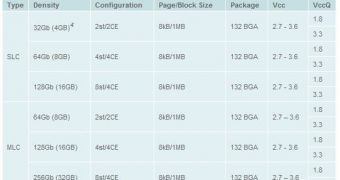Flash memory has been advancing at a steady pace and solid state drives (SSDs) have already earned their place as storage solutions that are much faster and enduring, at least from a certain point of view, than hard disk drives, but Toshiba appears to have decided they weren't fast enough, so it developed the 32nm double data rate Toggle Mode NAND.
The Toshiba DDR Toggle mode 1.0 NAND has a fast interface of 133 megatransfers per second, much more than the 40 MT/s enabled by legacy SLC (Single-level Cell) single data rate NAND.
Thus, the new memory is fit for high-performance solid state storage applications, including enterprise storage.
There is another special benefit. Because of the asynchronous interface it uses, similar to the one featured in conventional NAND, the DDR Toggle mode NAND does not need a clock signal, leading to lower power consumption and a simpler system design.
There are two sets of DDR Toggle mode NAND chips, one with MLC memory and one with SLC.
The MLC chips have densities of 64 Gb, 128 Gb and 256 Gb and Page/block size of 8kB/1MB, whereas the SLC ones have 32 Gb, 64 Gb and 128 Gb densities.
The DDR interface in the new NAND employs a Bidirectional DQS that generates input/output signals using rising and falling edge of the write erase signal.
What's more, the Toggle mode NAND has on-die termination that reduces crosstalk, as well as support for common legacy NAND commands, including basic, multi-plane and cache operations.
“Scalability to future high-frequency operation is enabled as a result of the bi-directional data signal,” states the official press release.”
“Toshiba recently announced a commitment to a new standard for the most advanced high-performance NAND flash memory, a DDR NAND flash with a 400Mbps interface.”
“This next generation Toggle Mode DDR NAND 2.0 is targeted to provide a three-fold increase in interface speed over Toggle DDR 1.0 and a ten-fold increase over the 40Mbps single data rate NAND in widespread use today,” the release concludes.

 14 DAY TRIAL //
14 DAY TRIAL //